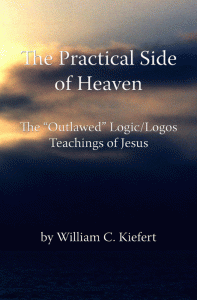
Copyright William C. Kiefert. All Rights Reserved.
Originally written on July 30, 2003.
The idea of stages in consciousness has existed since antiquity. Hindu models begin with the householder stage and end with Moksha. The Buddha teaches the five noble truths. Islam teaches the five Nafs. And today, Abraham Maslow, Teithard deChardin, Joseph Campbell, and many other psychologists teach what are, in principle, similar models.
Unlike others who base stages of consciousness on historical, spiritual, or moral development, St. Paul alone bases his model on rational development. Paul knew that everything is one. He, therefore, understood that what we call spiritual or heart-felt thoughts are what we could today call undeveloped nonjudgmental rational thoughts. Understanding the modern theory of reality is the key to Stage IV in Paul’s five stage model of rational consciousness because it justifies a nonjudgmental system of logical laws, and in turn, nonjudgmental reasoning and a consciousness of oneness.
STAGE I: In Paul’s Letters to the Romans 8:28-30, the “foreknown” are prehistoric, non-rational beings. Neanderthal man, for example, was a nonrational humanoid—human. The key to this stage is life itself.
STAGE II: The key to Stage II, those of us in the “image” of Jesus, is the idea of self, i.e. the “me me” we learn as toddlers. In practice, the sense of self we accept in Stage II conforms to the ancient theory of reality. Again, this theory justifies civilized man’s present system of judgmental logical laws, hence, judgmental reasoning. Those of us in the image are rationally similar to Jesus, but lack his ability to reason nonjudgmentally. At this stage, we also lack a conscience.
Stage III: The key to Stage III, the “called”, is the law. Laws establish a criteria of right and wrong, hence the ethical and moral standards of our conscience. In this stage, we are rational and have a conscience, but because judgmental laws of logic are the only standards available to us, we tend to accept immoral acts as right, even though we know in conscience they are wrong.
STAGE IV: The key to Stage IV, the “righteous” (from the Greek word right minded), is understanding the modern theory of reality. This theory justifies a nonjudgmental system of logical laws, and in turn, nonjudgmental reasoning and oneness. This is the missing link to Stage IV, right mindedness—enlightenment. Gnostic Christianity’s goal is to reveal this missing theory and its consciousness-raising potentials.
STAGE V: The key to the fifth Stage, the “glory”, is that time when all reach right mindedness of Stage IV. I believe Stage V represents synergistic consciousness; a consciousness in which the sum of both judgmental and nonjudgmental reasoning equates to the mind of Christ.
The consciousness of oneness that Jesus and today’s science support, then, is not reached through divine intervention, grace, meditation, or any other mysterious means. This consciousness of oneness is reached through factual knowledge (gnosis) about our judgmental/separating system of logical laws based on an ancient theory of reality and the need for an additional oneness/nonjudgmental-based system of logical laws based on the modern theory of reality. In actuality, to achieve a consciousness of oneness, we need to accept the modern theory and develop a system of nonjudgmental logic based on that theory. (Possible Ending?)
Historically, Jesus was more like Einstein, Newton, and some modern physicists than a divine being. From the perspective of Gnostic Christianity, Jesus taught a fact-based theory of reality that is, like Newton’s theory of gravity and Einstein’s theory of reality, true for everyone, everywhere, and for all time. One does not have to hold a particular doctrine; believe a particular religion or philosophy; or have a particular spiritual orientation to profit from Jesus’ modern theory of reality. We need only to understand his theory to benefit from both judgmental and nonjudgmental reasoning. Using both systems of reasoning can change the character of consciousness, and in turn, our experience of reality.
Apples cannot be explained in terms of oranges. No wonder, then, that religion and philosophy have given us good feelings and hope, but failed to change the world. Most believe that enlightenment is a benevolent gift of the Gods—Apples—when facts demonstrate it is up to us to transform ourselves—Oranges. To bridge the gap between separation (apples) and oneness (oranges), we need to add an additional nonjudgmental system of logical laws to our present judgmental system. Together, these two systems empower us to be conscious of our lives and the world in totally new ways. Our failure to recognize this is what locks us into a consciousness of the past and its seemingly irresolvable problems.
In summary, when Jesus said he was the fulfillment of the law, he was telling us that religion and philosophy based on judgmental reasoning alone had accomplished their tasks. They had brought us to the realization that we could not reach enlightenment—Stage IV—without understanding his modern theory of reality and nonjudgmental rules of logic based on it. This knowledge is the key to understanding oneness in the quantum sense that Jesus used it in Jn 17:21 and Gnostic Christians teach today.
